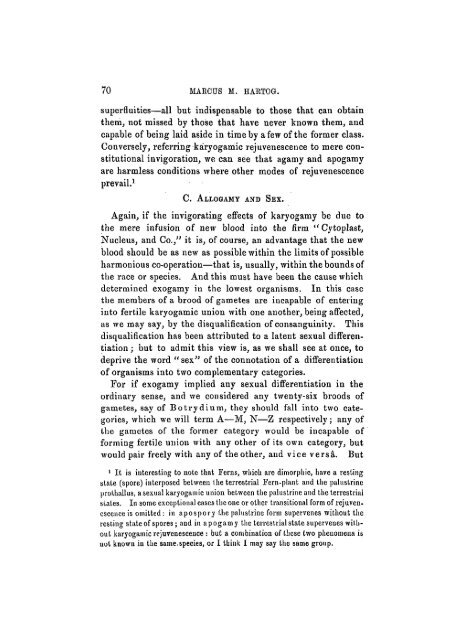Some Problems of Reproduction: a Comparative Study of ...
Some Problems of Reproduction: a Comparative Study of ...
Some Problems of Reproduction: a Comparative Study of ...
You also want an ePaper? Increase the reach of your titles
YUMPU automatically turns print PDFs into web optimized ePapers that Google loves.
70 MARCUS M. HAETOG.<br />
superBuities—all but indispensable to those that can obtain<br />
them, not missed by those that have never known them, and<br />
capable <strong>of</strong> being laid aside in time by a few <strong>of</strong> the former class.<br />
Conversely, referring karyogamic rejuvenescence to mere constitutional<br />
invigoration, we can see that agamy and apogamy<br />
are harmless conditions where other modes <strong>of</strong> rejuvenescence<br />
prevail. 1<br />
C. ALLOGAMY AND SEX.<br />
Again, if the invigorating effects <strong>of</strong> karyogamy be due to<br />
the mere infusion <strong>of</strong> new blood into the firm " Cytoplast,<br />
Nucleus, and Co.," it is, <strong>of</strong> course, an advantage that the new<br />
blood should be as new as possible within the limits <strong>of</strong> possible<br />
harmonious co-operation—that is, usually, within the bounds <strong>of</strong><br />
the race or species. And this must have been the cause which<br />
determined exogamy in the lowest organisms. In this case<br />
the members <strong>of</strong> a brood <strong>of</strong> gametes are incapable <strong>of</strong> entering<br />
into fertile karyogamic union with one another, being affected,<br />
as we may say, by the disqualification <strong>of</strong> consanguinity. This<br />
disqualification has been attributed to a latent sexual differentiation<br />
; but to admit this view is, as we shall see at once, to<br />
deprive the word "sex" <strong>of</strong> the connotation <strong>of</strong> a differentiation<br />
<strong>of</strong> organisms into two complementary categories.<br />
For if exogamy implied any sexual differentiation in the<br />
ordinary sense, and we considered any twenty-six broods <strong>of</strong><br />
gametes, say <strong>of</strong> Botrydium, they should fall into two categories,<br />
which we will term A—M, N—Z respectively; any <strong>of</strong><br />
the gametes <strong>of</strong> the former category would be incapable <strong>of</strong><br />
forming fertile union with any other <strong>of</strong> its own category, but<br />
would pair freely with any <strong>of</strong> the other, and vice versa. But<br />
1 It is interesting to note that Ferns, which are dimorphic, have a resting<br />
state (spore) interposed between the terrestrial Fern-plant and the palustrine<br />
prothallus, asexual karyogamic union between the palustrine and the terrestrial<br />
states. In some exceptional cases the one or other transitional form <strong>of</strong> rejuvencsceuceis<br />
omitted: in apospory the paluslrine form supervenes without the<br />
resting state <strong>of</strong> spores ; and in apogamy the terrestrial state supervenes without<br />
karyogamic rejuvenescence : but a combination <strong>of</strong> these two phenomena is<br />
uot known in the samespecies, or I think I may say the same group.

















